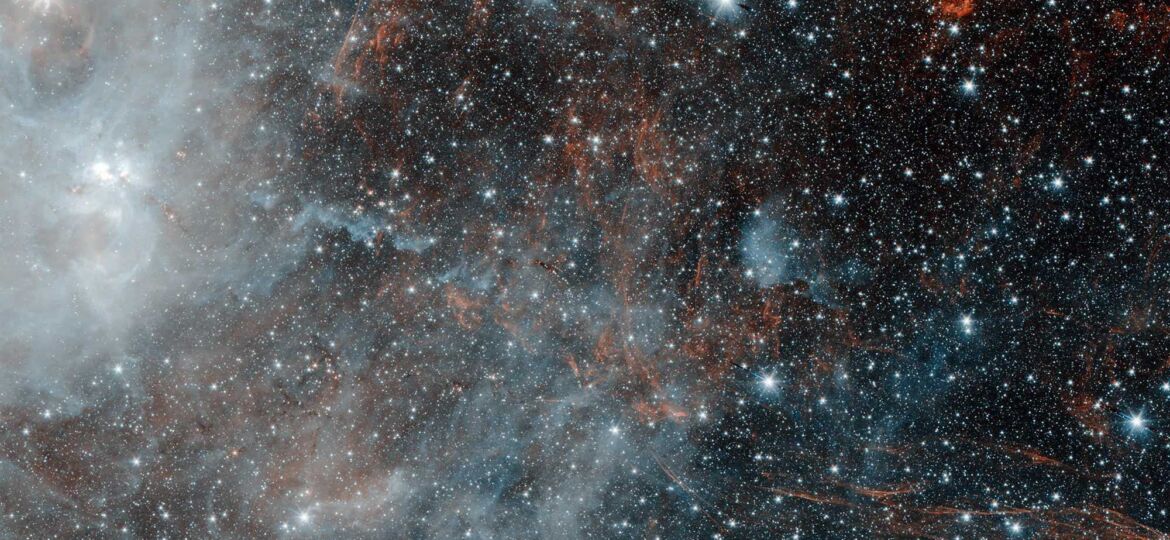
When we look up at the sky on a clear midnight, we see an expanse of darkness splattered with the remote fires of myriad stars. The stars of the Cosmos dwell in the billions of galaxies that exist in the visible Universe, which is that relatively small region of the entire incomprehensibly vast Cosmos that we are able to observe. This is because of the finite speed of light and the accelerating expansion of Spacetime. The light traveling to us from regions beyond our cosmological horizon has not had enough time to reach us since the Big Bang birth of the Universe almost 14 billion years ago. One of the greatest mysteries confronting astronomers today is understanding how galaxies form. According to the prevailing theory of galactic formation, small galaxies were born first, eventually merging together in the ancient Universe to form the large, majestic galaxies seen in the Universe today. However, large galaxies have been observed to haunt the very ancient Cosmos, and they should not be there according to this bottom up theory of galaxy formation.
In October 2019, a team of astronomers reported that they have by chance discovered dim traces of an enormous “monster” galaxy never seen before, dating from the very early Universe. Making a playful comparison of their galactic discovery to photographing the footprints of the mythical monster Yeti–the “abominable snowman” of the Himalaya people–the astronomers commented that the scientific community once believed that such galactic behemoths were just folklore. This is because there was no evidence for their true existence in nature–until now.
The team of astronomers, led by postdoctoral fellow, Dr. Christina Williams of the University of Arizona (Tucson), say that their discovery provides new insights into the first baby steps of some of the largest galaxies in the Universe. The research paper appears in the The Astrophysical Journal.
Dr. Kate Whitaker, who is an assistant professor at the University of Massachusetts Amherst, and a member of the team, is an expert in early galaxy evolution. She noted in an October 22, 2019 Amherst Press Release that “These otherwise hidden galaxies are truly intriguing; it makes you wonder if this is just the tip of the iceberg, with a whole new type of galaxy population just waiting to be discovered.”
The Birth Of Galaxies
There are currently two leading theories seeking to explain how the first galaxies were born in the ancient Cosmos. However, some astronomers propose that the truth may really involve both ideas.
One of the prevailing theories proposes that the first galaxies formed when enormous clouds composed of gas and dust collapsed under their own gravitational pull–thus enabling stars to be born. This is sometimes referred to as the top-down theory.
The second theory, the bottom-up theory, has gained considerable credibility in recent years. According to this idea, the young Universe contained numerous relatively small blobs of matter. These small amorphous blobs (protogalaxies) met up with one another and merged, ultimately growing into the large galaxies that we observe in the Universe today. The Hubble Space Telescope (HST) has photographed many of these clumps of material, which may be the “seeds” that eventually became modern galaxies. According to this theory, most of the ancient large galaxies were spirals. However, as time went by, many of the spirals collided and merged together to create elliptical galaxies. Ellipticals are very large egg-shaped galaxies that primarily host elderly red stars. The stars dwelling within elliptical galaxies travel in chaotic orbits, which are unlike the stellar populations of the orderly and more elegant spirals that host stars of all ages–such as our own Milky Way Galaxy.
But the process of galactic birth has not come to an end. The Universe continues to evolve in time. Small galaxies are frequently devoured by the larger ones. Our own Milky Way may contain the tragic remnants of former feasts–having gobbled up many of its smaller galactic kin, in much the same way that big fish devour their tiny neighbors. Currently, our Galaxy is digesting at least a duo of unfortunate small galaxies–and it may very well hoist in others over the next few billion years. Such mergers are common because the Cosmos is crowded on the galactic distance scale.
Indeed, there is a massive merger in our Galaxy’s distant future. The nearest major galaxy, the large spiral Andromeda–which is slightly bigger than our Milky Way–is currently a safe 2.5 million light-years away. This means that the distance between this duo of large galaxies is only about 25 times greater than the sizes of the galaxies themselves. Like our own Galaxy, Andromeda hosts stars of various ages and contains a rich supply of gas. Gravity is pulling Andromeda towards us at about 100 kilometers per second. In about 4.5 billion years, the Andromeda galaxy and our Milky Way will collide and form a single, immense elliptical galaxy that astronomers have already dubbed the great Milkomeda galaxy. The future Milkomeda galaxy will be twice as large as the duo of ill-fated spirals that crashed into one another to create it. The supermassive black holes, that haunt the dark hearts of both erstwhile spirals, will also merge, becoming twice as massive as the two black holes that collided to form a single entity. Technically, however, the Andromeda galaxy will eat our Milky Way. This is because Andromeda is a slightly larger galactic “fish”.
Galaxy mergers were more common in the early Cosmos than they are today because during that ancient time the Universe was smaller and considerably more crowded than it is now. Therefore, the small galactic “blobs” had a better chance of bumping into one another and merging. It is generally thought that the ancient galaxies were different from those we see today. The early galaxies displayed much greater diversity, and there was a much larger population of irregular galaxies, which are usually small galaxies that sport low masses–and have no specific form.
Which brings us to the strange existence of the “monster” galaxy that should not exist in the early Universe, where it was once thought that only smaller protogalaxies could exist–and perform their fiery dance in the newborn light of the Cosmos.
The good news is that galactic collisions rarely result in head-on wrecks between individual constituent stars inhabiting the colliding duo. Even when two galaxies crash into one another, the distance between their stars is so vast that they rarely suffer in the wake of the catastrophe. However, there are stars that can suffer as a result of the wreck. Some stars can be thrown into new orbits, or even shot howling out of their parent galaxies altogether, doomed to wander lost and alone in the dark wilderness of intergalactic space.
Even though galactic collisions usually do not destroy stars, they frequently result in star-birth. As enormous clouds composed of gas and dust within the merging galaxies crash together, they can give birth to millions of bright new searing-hot baby stars.
A Galactic Goliath That Shouldn’t Be There
Dr. Williams and her team used the Atacama Large Millimeter Array (ALMA) collection of 66 radio telescopes, located high in the mountains of Chile, to make their discovery. In new observations conducted with extremely sensitive detection limits, Dr. Williams spotted a blob of very faint light. “It was very mysterious, but the light seemed not to be linked to any known galaxy at all. When I saw this galaxy was invisible at any other wavelength, I got really excited, because it meant that it was probably really far away and hidden by clouds of dust,” Dr. Williams commented in the October 22, 2019 Amherst Press Release.
The astronomers estimate that the faint signal originated from so far away that it took 12.5 billion years to arrive at Earth. At that time, the Universe was still in its infancy. The scientists think that the observed emission results from the warm glow of dust particles (which effectively obscure all light) that have been heated up by fiery stars being born deep within a young galaxy.
Study co-author, Dr. Ivo Labbe, noted in the Amherst Press Release that “We figured out that the galaxy is actually a massive monster galaxy with as many stars as our Milky Way but brimming with activity, forming new stars at 100 times the rate of our own Galaxy.” Dr. Labbe is of the Swinburne University of Technology in Melbourne, Australia.
The new discovery is important because it can potentially solve a long-standing puzzle in astronomy. Some of the biggest galaxies inhabiting the early Universe appear to have grown up and matured very rapidly, which conflicts with theoretical predictions of the bottom-up theory of galaxy formation. Even more mysterious, these large mature galaxies seem to have come out of nowhere when the Universe was comparatively young–a mere 10% of its current age, the astronomers point out.
Furthermore, astronomers never seem to catch them at the point where they are first forming, Dr. Williams continued to explain to the press. Smaller galaxies have been observed in the early Universe with the Hubble Space Telescope, but they are not growing rapidly enough. Other monster galaxies have also been previously reported. However, those sightings are much too rare to provide a satisfying explanation of what was occurring at that ancient time. “Our hidden monster galaxy has precisely the right ingredients to be that missing link, because they are probably a lot more common,” Dr. Williams continued to comment in the Amherst Press Release.
The unresolved mystery today, the astronomers note, is exactly how many of these behemoth galaxies there are. The current study was done in a small region of the sky–less than 1/100th the size of the full Moon. It could mean that finding “Yeti footprints” in a tiny strip of wilderness means either it was a lucky find, or they are cloaked in shrouds of dust–but hiding everywhere.
Dr. Williams added that “Right now we are eager for the James Webb Space Telescope (JWST) to take a look at these things. JWST will be able to look through the dust veil so we can learn how big these agalaxies really are and how fast they are growing, to better understand why models fail in explaining them.”
The JWST is an upcoming revolutionary new telescope scheduled to launch in March 2021.
AUTOPOST by BEDEWY VISIT GAHZLY


